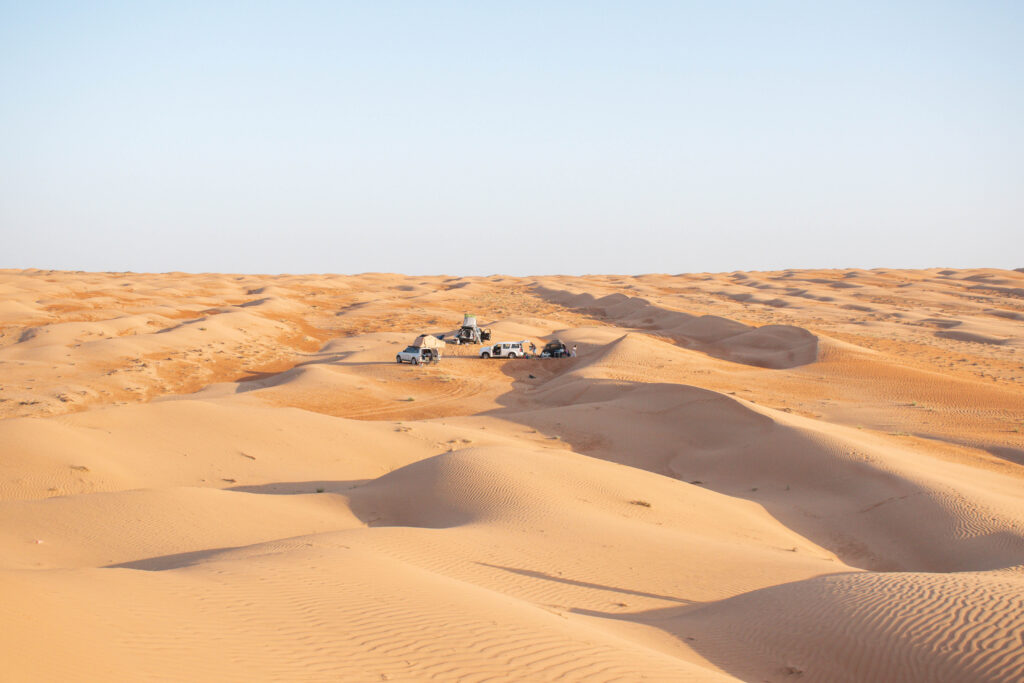
It is legal to camp almost anywhere in Oman – including camping in the desert. Waking up amongst the dunes is a memorable experience and is how we spend most of our weekends as soon as the temperatures drop low enough in the autumn months. However, if a tent and camp cot are not your thing, fear not. Oman also has plenty of luxurious glamping camps to cater to the more discerning traveller.
This guide covers my favourite places to wild camp and my top picks for glamping. It also has advice on what to pack for your own Wilfred Thesinger-style adventure.
Whenever you camp – in the desert or elsewhere – remember to follow the Leave No Trace principles. Be sure to take all of your rubbish home with you. Sadly, many of Oman’s most beautiful landscapes are increasingly blighted by discarded litter. Consider bringing an extra bin bag to help protect this beautiful environment.
“In the desert I found a freedom unattainable in civilisation; a life unhampered by possessions, since everything that was not a necessity was an encumbrance”
Wilfred Thesinger
DESERT INHABITANTS: THE BEDOUIN OF OMAN
A Bedouin is a nomadic desert traveller. In Oman, the coastal tribes have been settled for hundreds of years, but desert tribes maintained a nomadic lifestyle for far longer.
There are three major tribes in central Oman – the Junaiba, the Wihibah and the Harasis. Today, only about 5% of Oman’s population live as “nomads” in the Omani deserts. Although most now live in permanent structures, rather than the traditional tents.
The welcome of the desert peoples is famous. Tradition dictates hospitality must be offered to guests and unexpected visitors – even if this meant their own family going without.
Camels are the lifeblood of the Bedouin. They are uniquely well suited to the desert – they don’t even start to sweat until their body temperature reaches 40C/104F. The Bedouins therefore relied on camel milk in the desert, long after water supplies ran out.
If you want to find out more about the Bedouin, check out the evocative Arabian Sands by Wilfred Thesigner. Written in 1959 it tells the story of Thesigner’s travels across the Empty Quarter between 1945 and 1959. His descriptions of Bedu life and hospitality are vivid.
WHERE TO WILD CAMP IN OMAN’S DESERTS
Usually, half the fun of wild camping is setting out to find a camp site. However, the desert is not an environment to be underestimated. I strongly recommend doing some research on potential camp sites before you depart. i-Overlander (iOS/Android) is a great place to start. There are usually a few options marked, often with a short description and sometimes even a picture. The excellent Oman Off-Road guidebook also marks suggested camping spots on all their routes. You can usually get a copy in the bookshop in Muscat Airport, Spinney’s at the Wave/Al Mouj or sometimes in the Al Fair supermarket.
I thought long and hard about whether or not to provide coordinates to specific camping spots we have found. On the one hand, conservation groups around the world are increasingly asking visitors not to share geotags as such significant damage is being done to fragile environments unable to handle the volume of traffic they are getting. But on the other hand, geotagging opens up access to the outdoors, safely, for a wider group of people or for those who may not know the locality well. Camping in the desert is not without risks. If you are only here for a short trip – or travelling with only one car – it is important to know where you will be safe and less likely to get stuck.
On balance, I decided given the terrible litter problem that already exists in Oman, I did not want to openly recommend specific locations. I have therefore provided more general advice below. However, I am more than happy to share the coordinates for our favourite camp spots if you get in touch when you are planning your visit to Oman. Send me a message on Instagram for the quickest response.
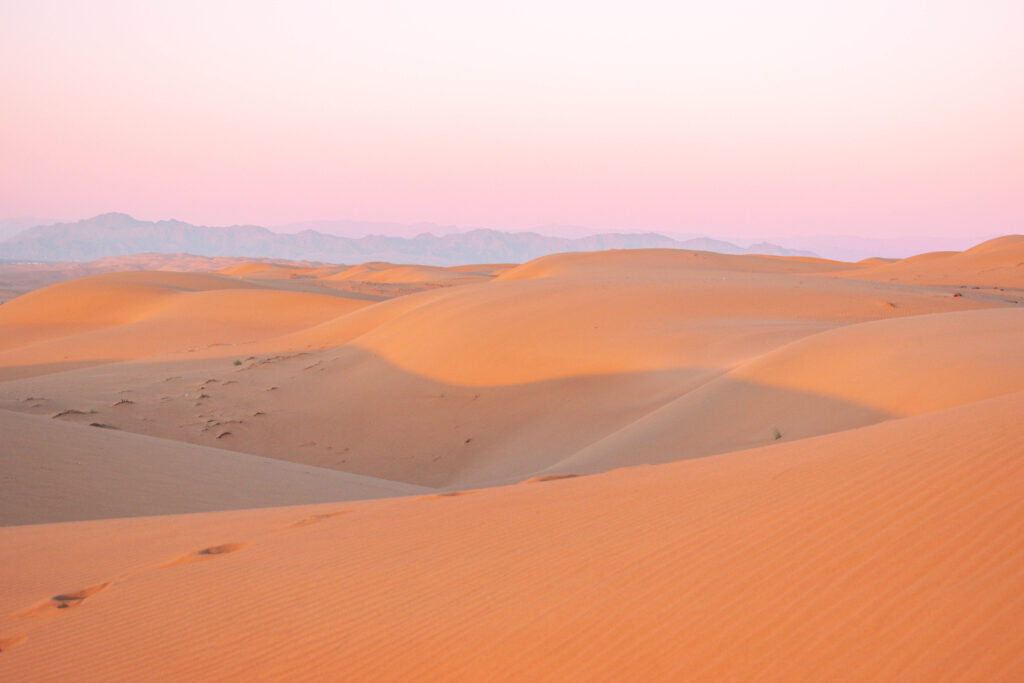
WAHIBA/SHARQIYAH SANDS
Stretching 125 miles from the eastern Hajar Mountains to the Arabian Sea, and known variously as Shariqiyah or Wahiba Sands. These are the deep golden sands dunes of children’s picture books.
The dunes run north to south in unexpectedly regular valleys. Reaching heights of up to 100m, the dunes are highest towards the east, close to the ocean, and get lower the further west you are. The southern dunes are particularly treacherous, with numerous salt flats.
The dunes move constantly thanks to the wind – by as much as 10m per year. Fairly permanent tracks run down the valleys between the dunes, with a regular flow of tourists and locals ensuring they remain quite well compacted.
Wahiba is only two and a half hours drive from Muscat, making this the most convenient weekend desert camping destination for most Omani residents. It is therefore the most popular, and whilst that means help is usually not too far away, it can also mean you are more likely to encounter other campers. Although with 4,800 sq miles of desert, you are unlikely to struggle to find a quieter spot.

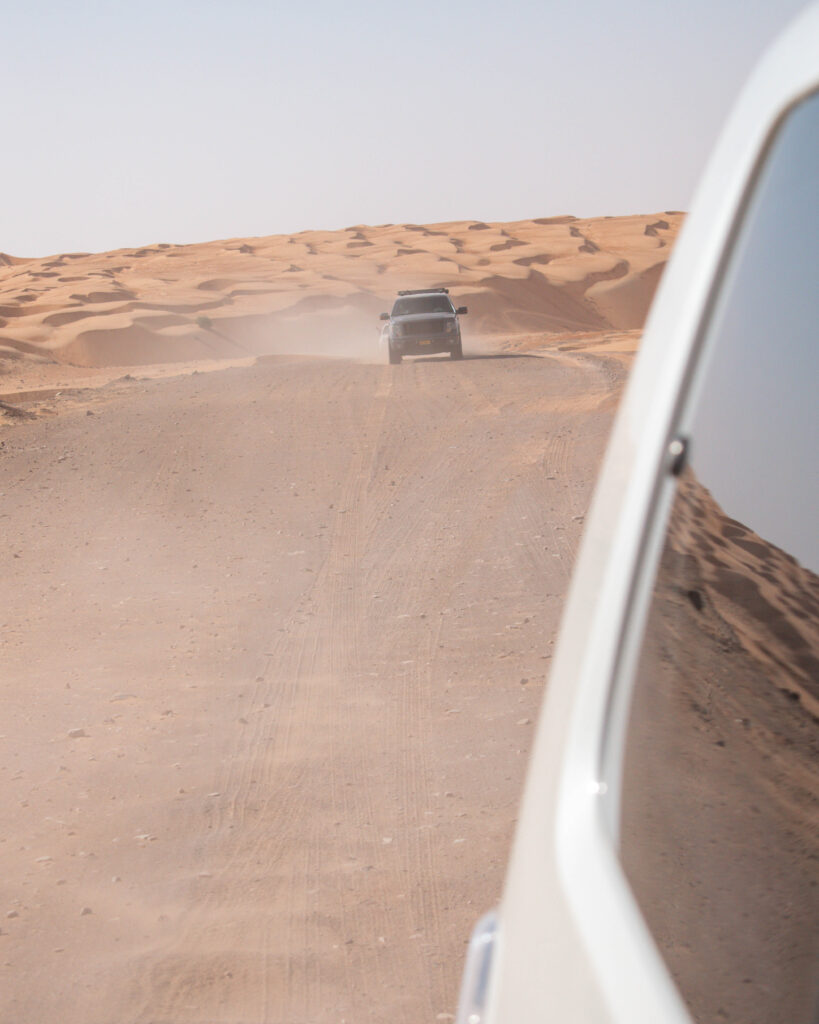
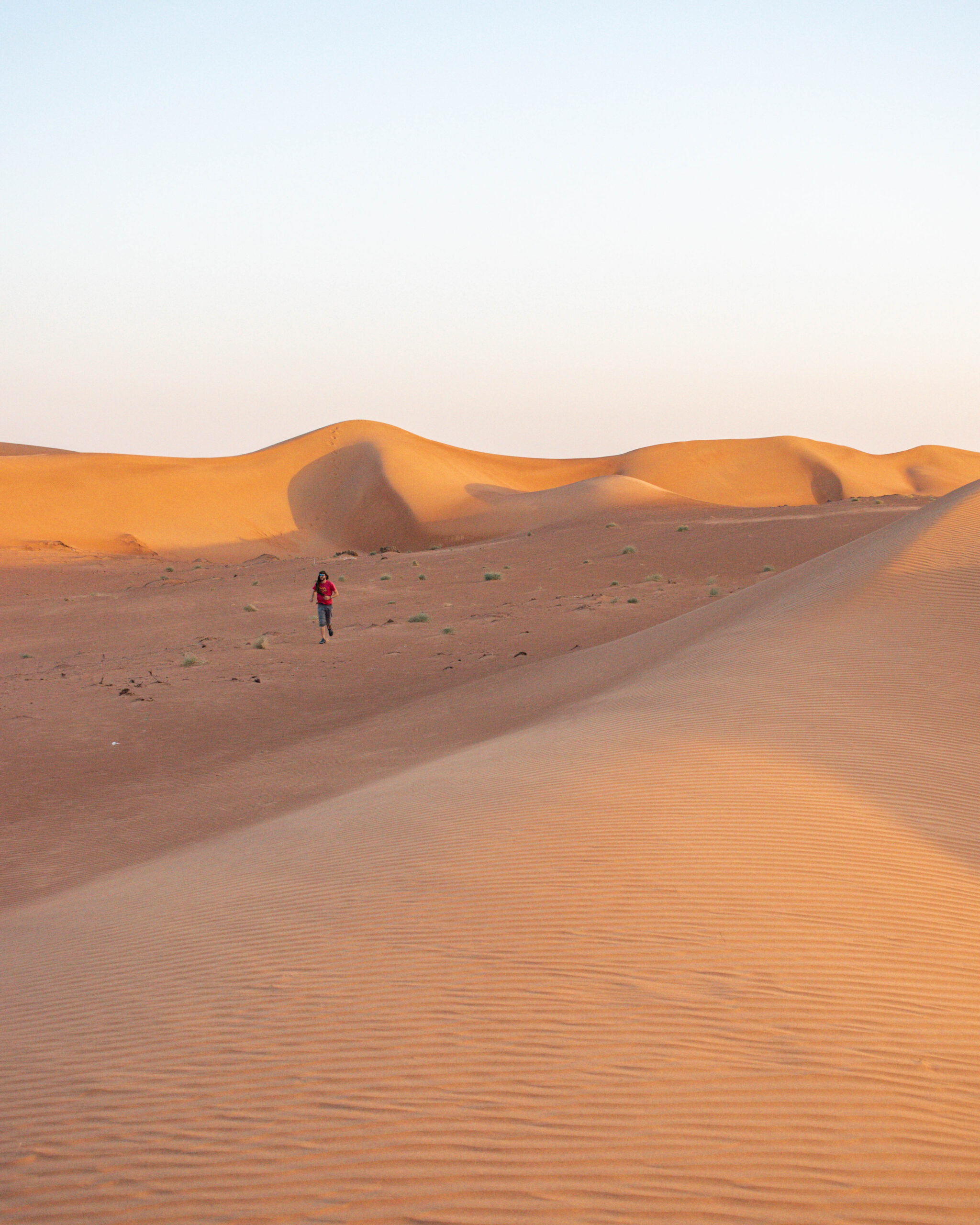
If you are only on a short trip to Oman, I recommend heading down the first track into the dunes, on the western side of the dunes. A tarmac road takes you right up to the edge of the desert, and the first mile or so of sand track is usually well compacted, making for easier driving if you are not experienced on the sand. You can camp off to either side of this track, metres from the bottom of the dunes without needing to do any extreme off roading.
The petrol stations at Al Wasil and Bidiyah are most convenient for inflating and deflating your tyres. There is a large Lulu’s Hypermarket at Ibra (about 20km away), and the petrol station at Al Barwani has a very small shop for cold drinks and snacks.
SUGAR DUNES
Also known as the White Desert or Al Khaluf Dunes, the Sugar Dunes are 400km to the south of Muscat. It is one of the most beautiful landscapes I have seen. The colours at sunrise and sunset are mesmerising and otherworldly.
The sand in the Sugar Dunes is particularly soft sand, and the pale white makes it even harder to spot the areas likely to be most treacherous. If you want to drive into the dunes, you must have a 4WD with proper recovery kit (shovel/sand tracks). Phone signal is extremely limited and there is almost no passing traffic.
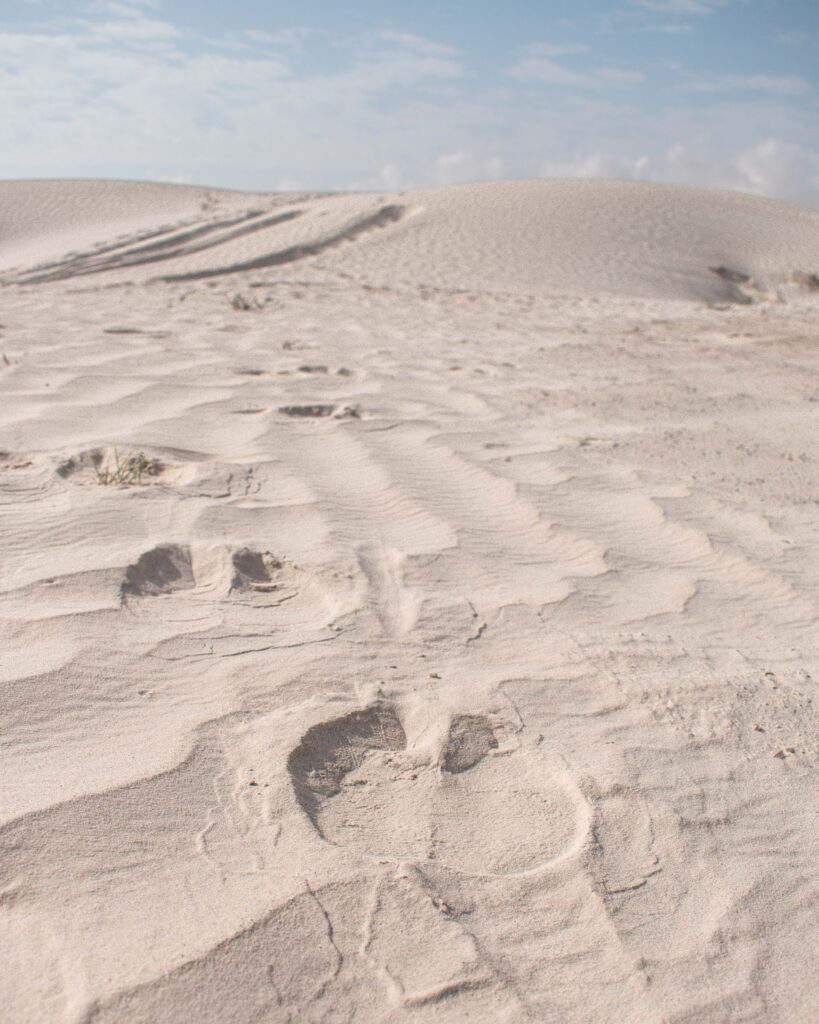
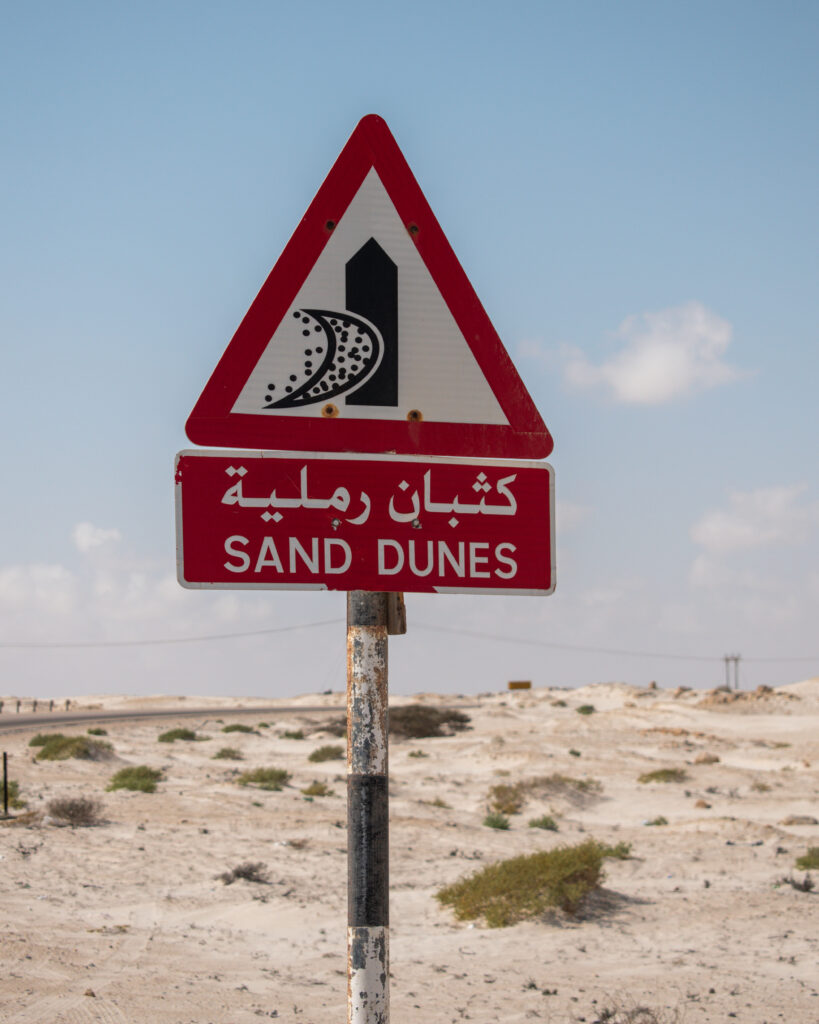
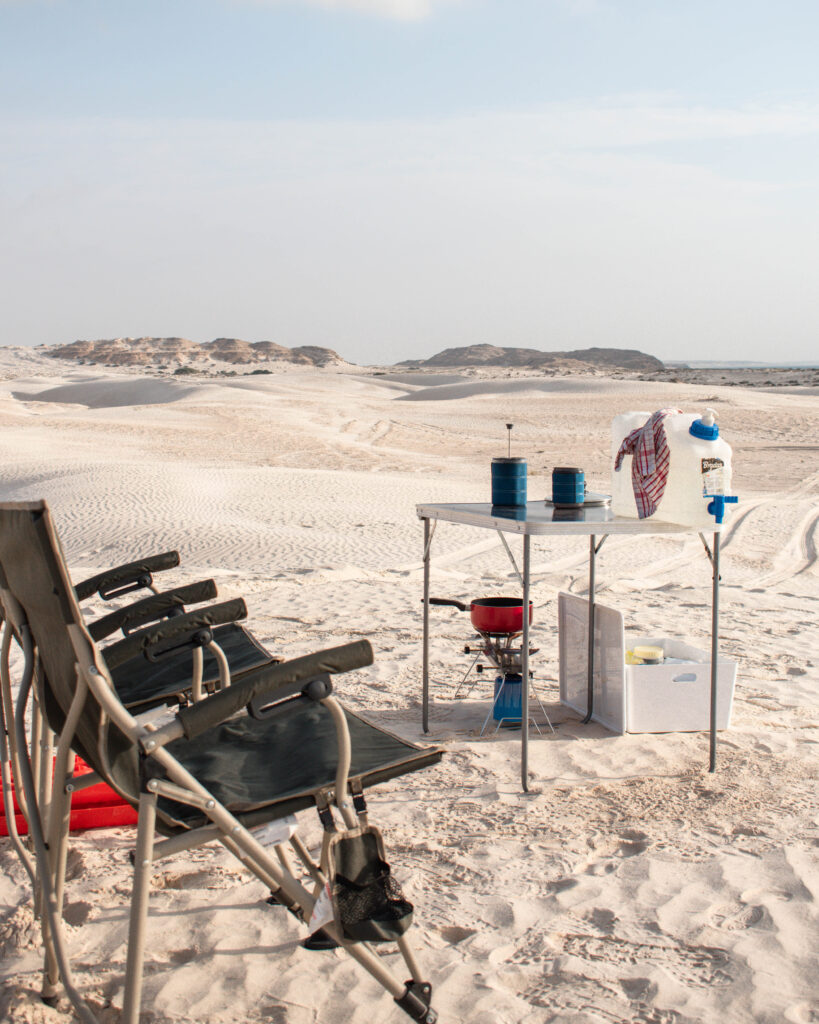
There is currently no infrastructure in the Sugar Dunes, although last time we visited, construction had started on a hotel at the southern end of the beach. I can’t help feeling this will detract from, rather than add to, one of Oman’s most beautiful wildernesses. Sadly the beach at Al Khaluf already has a very serious litter problem.
The Sugar Dunes are about a five hour drive from Muscat (approx. 400 km), so best attempted as a multi-day trip, or as part of a longer itinerary (perhaps to Sur and Ras Al Jinz, or down the length of the Omani coast to Salalah). For a really spectacular desert camping expedition, you could combine a crossing of the Wahiba with a visit to the Sugar Dunes.
I recommend following a route very similar to that set out in the Oman Off Road guidebook, although we think it best done in reverse. From Muscat, I recommend heading down Highway 32, parallel to the dunes before turning onto the road that leads down towards the beach (coordinates: 20.344188, 57.782989). As the sand here is so soft, and less visited, tracks change regularly so it is worth downloading a GPS navigator (we use the excellent Gaia) to plot a course from this track onto the much better defined route that runs along the beach (southern coordinates: 20.375412, 57.940955). Driving north along this route there are a number of places to turn off into the dunes proper.
If you are not confident driving on sand, it is possible to camp just off the beach track and the base of the start of the dunes. However, given the amount of litter on the beach I strongly recommend camping in the dunes themselves if possible. It can often also be quite popular along the beach, but you will nearly always have the dunes to yourself. Given the dunes by the beach are only a couple of metres high, you could always park up by the beach and clamber up with your tent into the dunes.
When leaving the Sugar Dunes, continue driving north along the well defined beach route until you curve around behind a rockier outcrop (coordinates: 20.433156, 57.993669) and find yourself actually on the sands of Al Khaluf beach. This 15km beach drive is one of my favourite off road stretches in Oman (although sadly the amount of plastic waste is growing exponentially). The route back into the small fishing village of Al Khaluf is easy to follow, and starts to curve back inland just after Humrat/AL Khaluf Caves (coordinates: 20.456114, 58.047574). You can stop to visit the cave – park in the strange, large walled enclosure and the entrance to the cave is on the right as you face the sea.
There is a small petrol station in the fishing village of Al Khaluf, and regular larger stations along Highway 32.
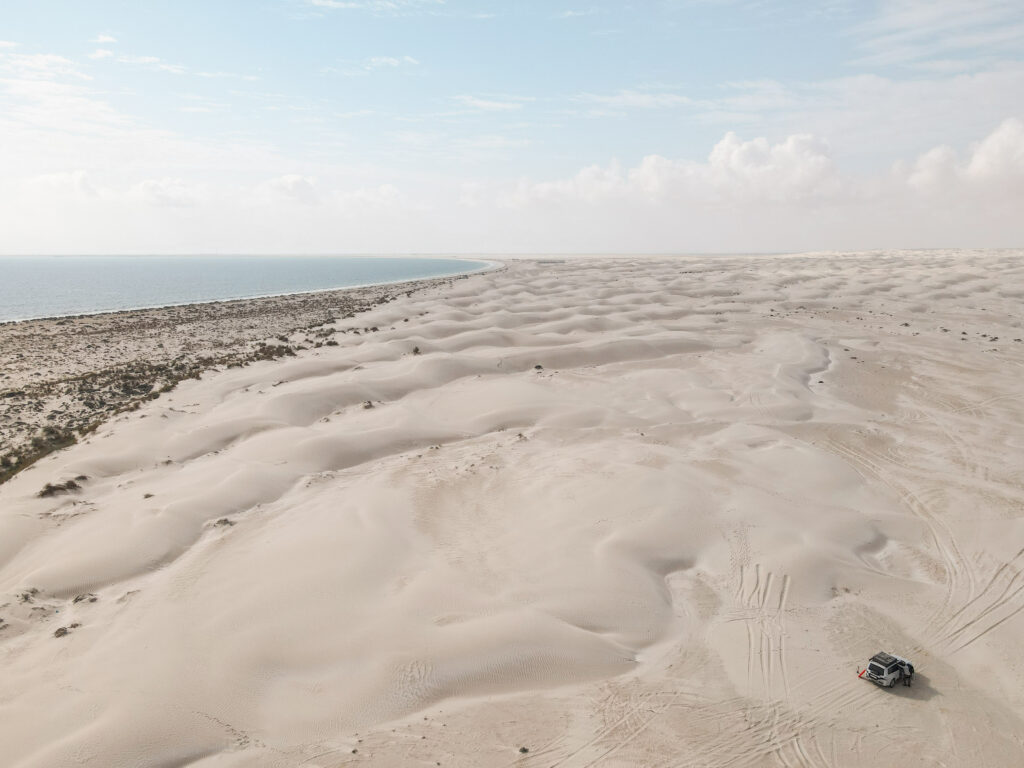
RUB’ AL KHALI
Most famously known in English as the Empty Quarter. Crossing the borders of Saudi Arabia, Oman, the UAE and Yemen, the vast Empty Quarter covers an astonishing one million square miles. That’s forty thousand square miles larger than France… although I am not clear why so many guidebooks have chosen to use France as the benchmark for desert sizes! It is the largest area of continuous sand in the world.
Of the three deserts described here, the Rub Al Khali is the most serious undertaking. Partly due to the soft sand, but also as it is extremely remote, and a long way from any kind of assistance. Do not underestimate the environment you are heading into – daily temperature hover between 47 °C (117 °F) and 51 °C (124 °F) and yearly rainfall is less than 3 cm (1.2″). Whilst this all makes for an amazing wilderness trip, this is definitely one only to attempt on an organised tour or with a convoy of vehicles with some experienced off road drivers.
Visiting the Empty Quarter from Muscat requires a very long drive, most of the length of the Sultanate. Alternatively, if time is tighter, fly into Salalah airport. There are daily flights to and from Muscat. From Salalah, getting to the dunes requires a drive northwards for about three hours (250km) on increasingly bumpy, corrugated roads. Petrol stations get fewer and further between, with the closest to the dunes close to the ruins of Ubar. However, the fuel supply is not always reliable, so do not rely on it for your first/last refuel. There are several larger petrol stations at Thumrait.
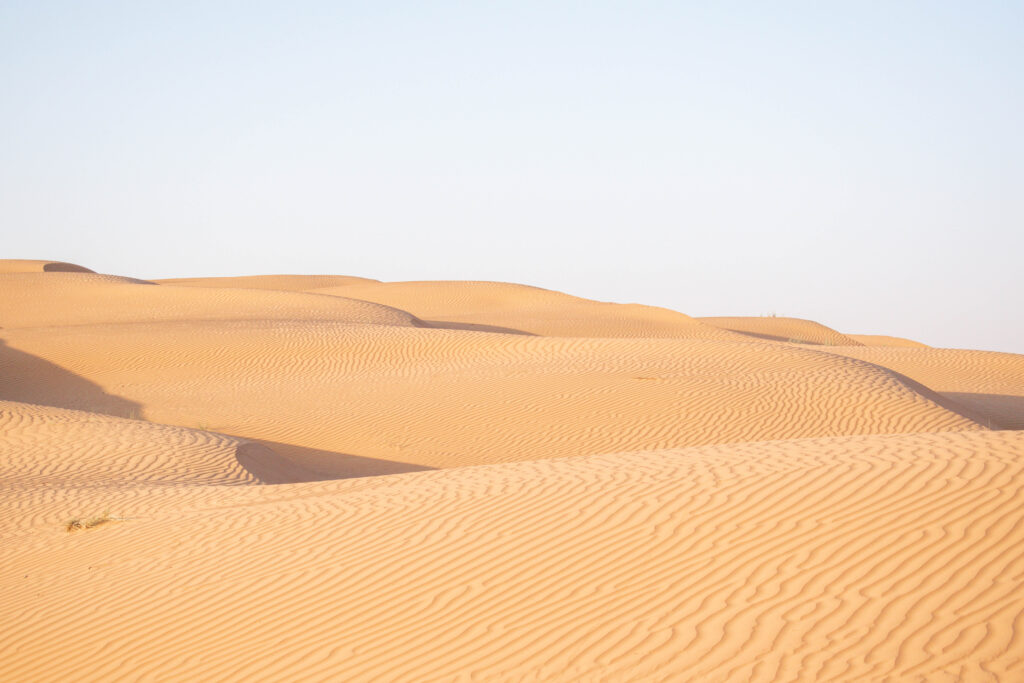
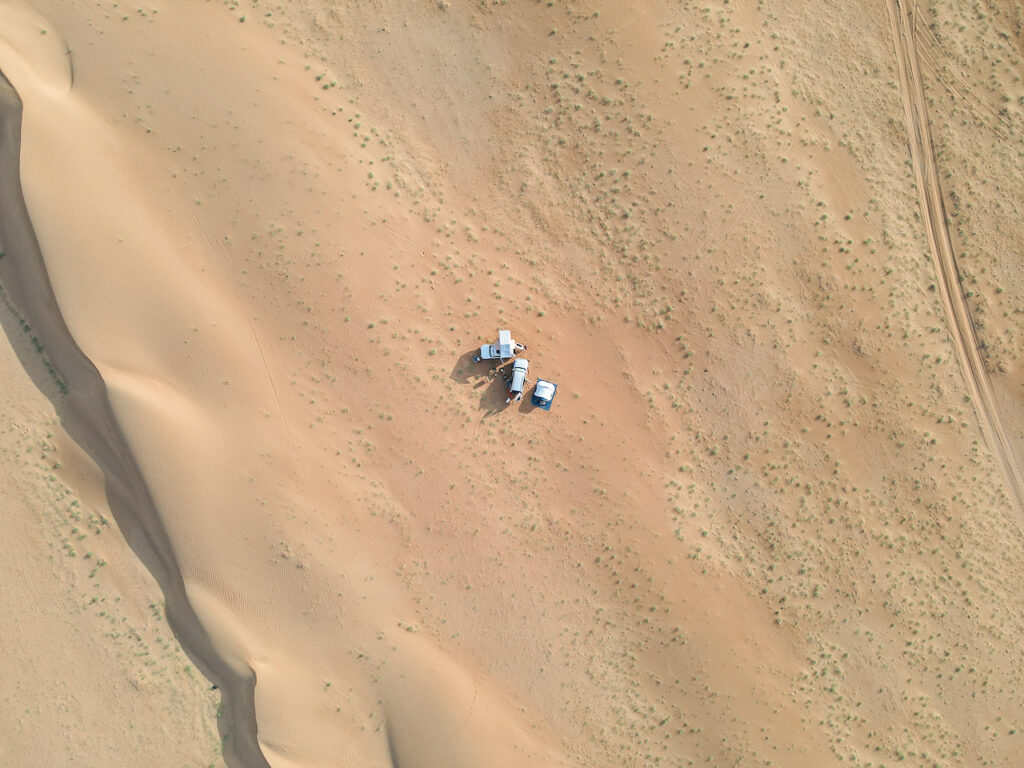
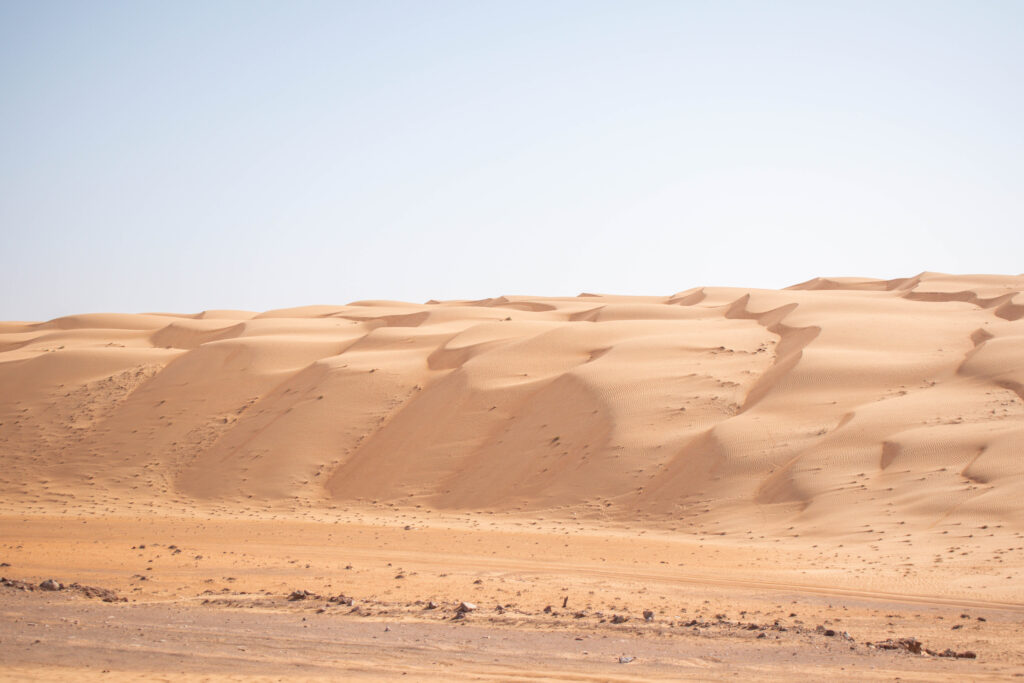
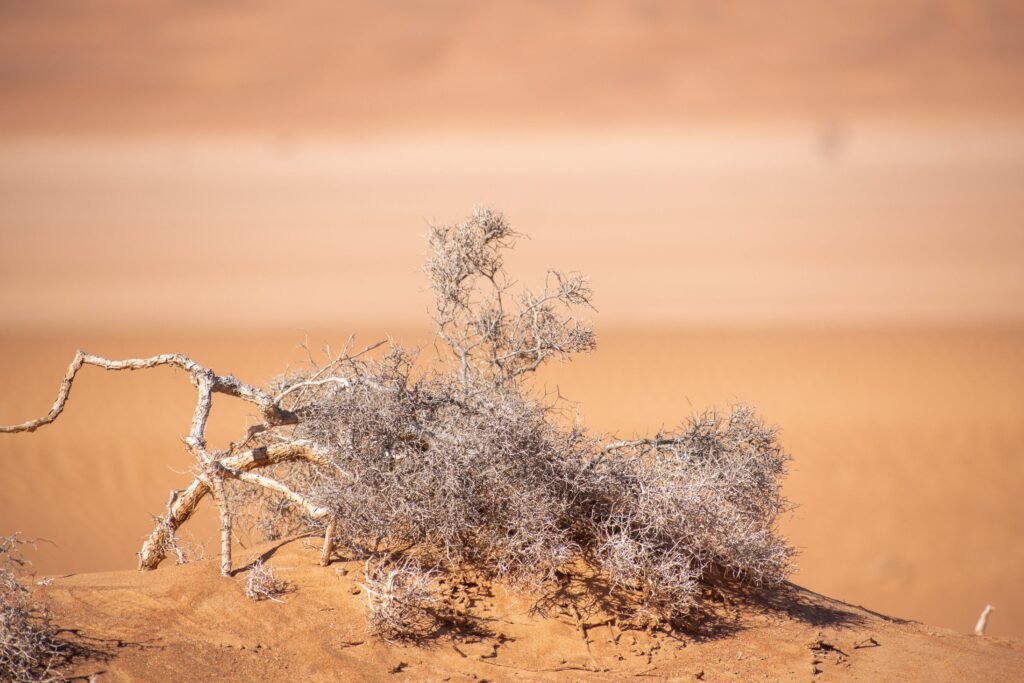
If you are making the trip all the way to southern Oman to see the Rub al Khali, you must not miss a visit to the ruins of the Lost City of Ubar. Mentioned in both the Bible and the Quran, this ancient Arabian city was the centre of the lucrative frankincense trade as early as 3,000 years BCE. Even the Queen of Sheba is said to have been here to buy frankincense. Although historians continue to debate whether this really is the lost “Atlantis of the Sands”, the romance of the legends make it worth a visit if you are already heading this far for some desert camping. The road from Thumrait is now paved and signposted from the main road.
TOP DESERT CAMPING TIPS
Bring lots of drinking water, always more than you think you will need. However much you think you need, pack double! We also freeze brown (non-drinking) water to help keep the cool box chilly, and melt as needed for washing up etc.
Set up your tent and camp on a flat area, ideally slightly away from the base of a dune or on a plateau in the dunes to ensure you can be easily seen by others. You don’t want to find someone coming down the side of a dune straight into your camp in the middle of the night. In the busier dunes it can help to leave a small camp light on to highlight your presence.
The wind can really pick up at night in the desert, so seek out a camp spot between dunes or in a slight dip to offer a bit of a wide break.
Try to keep to established tracks as much as possible. The environment in the Middle East is tough and the plants and animals already have it tough enough without tyres ripping everything to bits. For this reason I would personally not go dune bashing. Across the Gulf, dune bashing is the leading cause of severe desertification, an environmental degradation where desert vegetation and wildlife are lost entirely. Although it may see barren, the top layer of desert sand holds dormant seeds waiting to spring back to life as soon as it rains. Dune bashing displaces this layer, meaning there is nothing left to grow when the rains come, leaving nothing for desert animals to eat, removing shade and further reducing the plant biodiversity vital to sustain life in the desert.
CREEPY CRAWLIES
Despite its outwardly barren appearance the Omani deserts are home to lots of different creatures. The vast majority are harmless, although a few might give you a nasty bite if they are threatened or provoked.
There are some poisonous animals indigenous to Oman, most notably snakes and scorpions. The venemous horned viper, carpet vipers, puff adder and cobra snakes are all found in Oman, although are rare. The deathstalker scorpion also lives in Oman, and one of the world’s most venomous scorpions. Whilst extremely painful, their bite is unlikely to kill a grown adult (but would be very dangerous to children) and they are also very rare. Camel spiders inhabit the deserts of Oman, and whilst looking really terrifying, their bite is painful, but not deadly to humans.
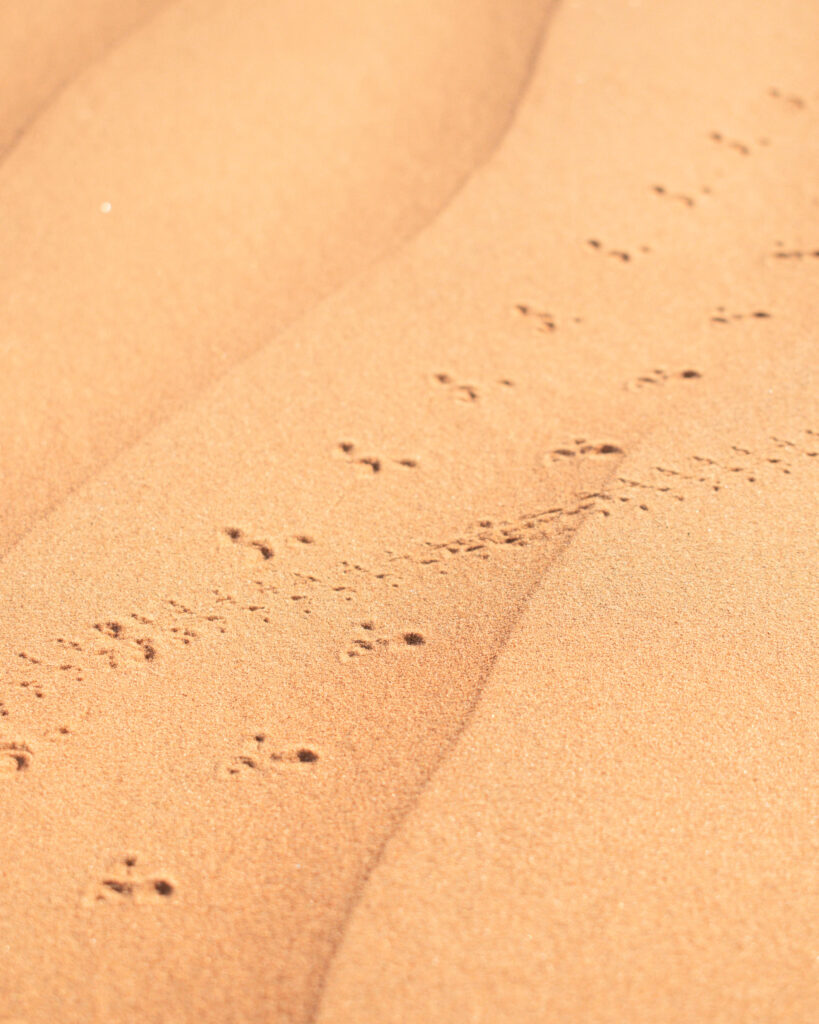
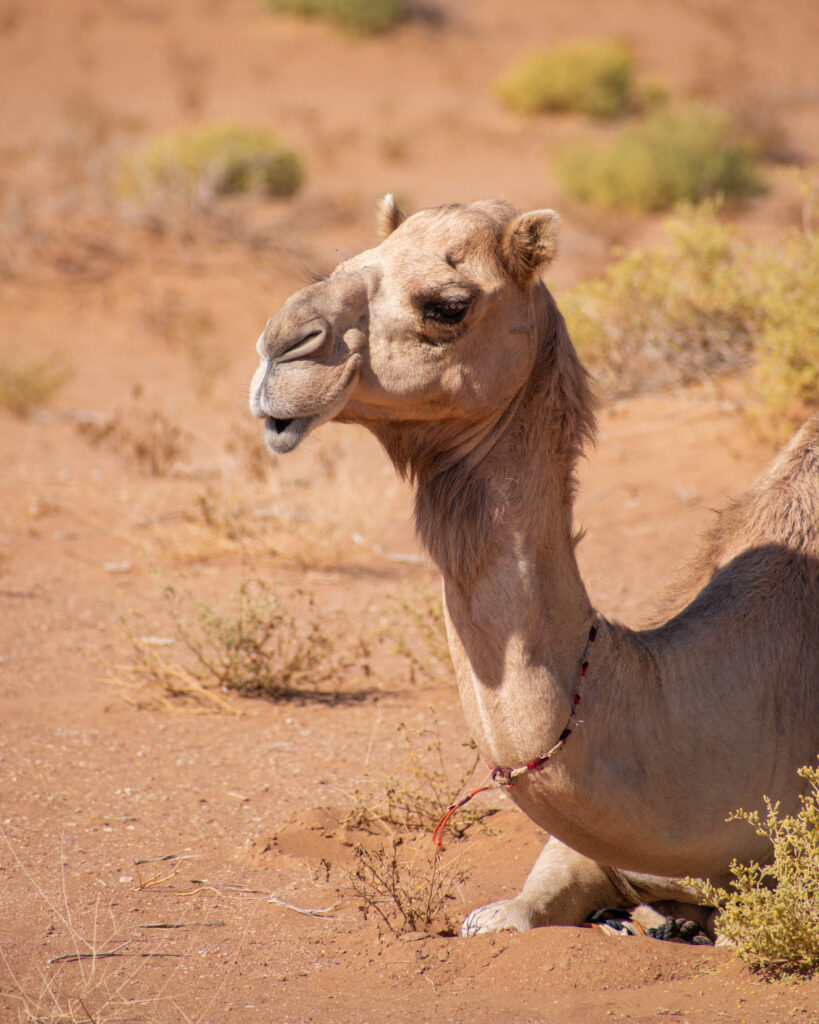
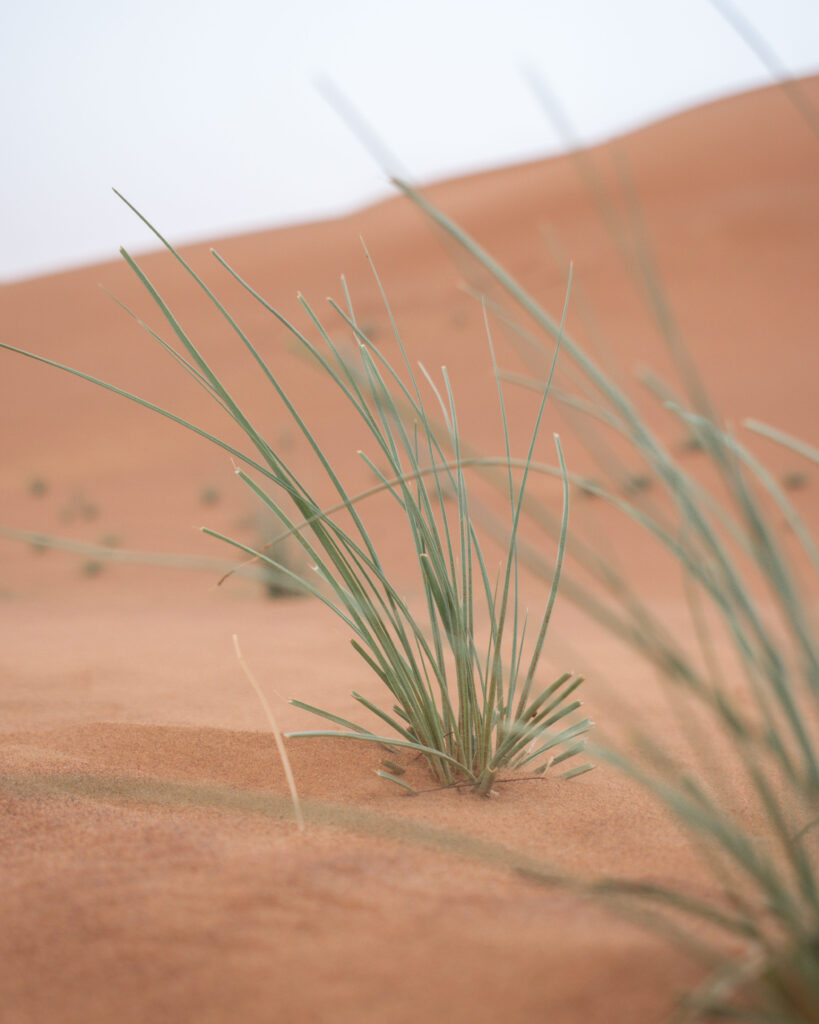
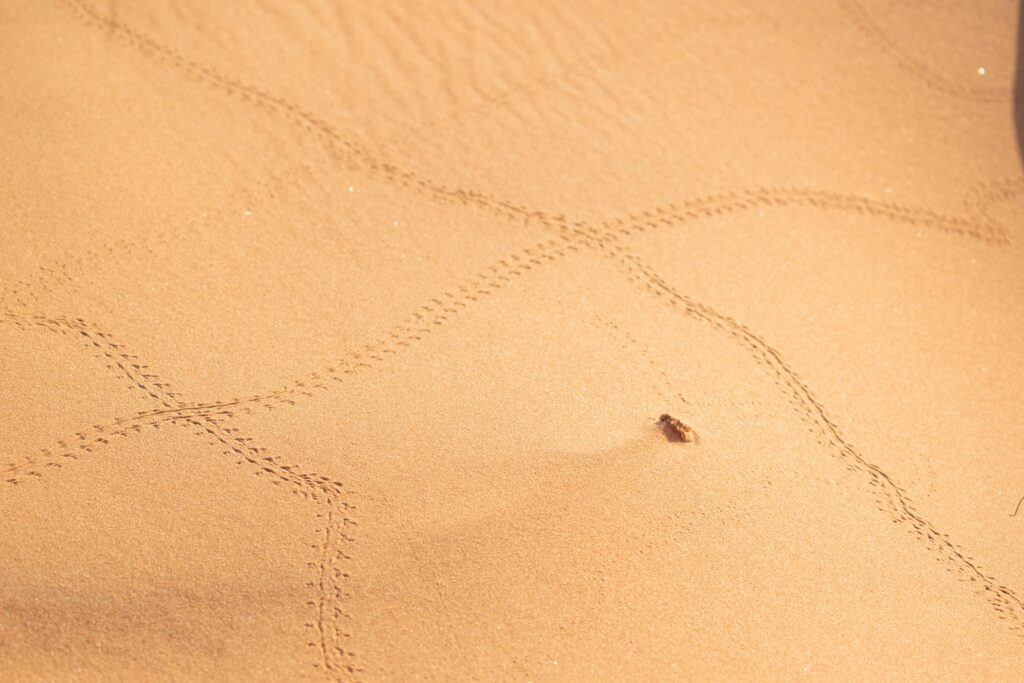
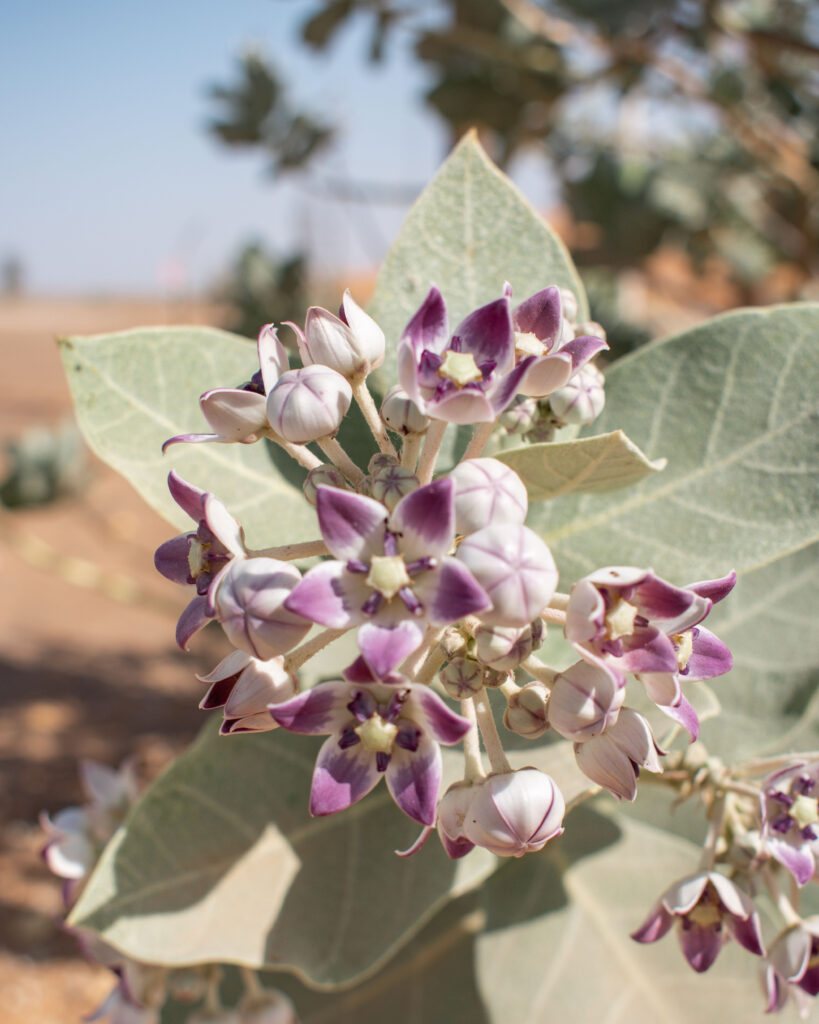
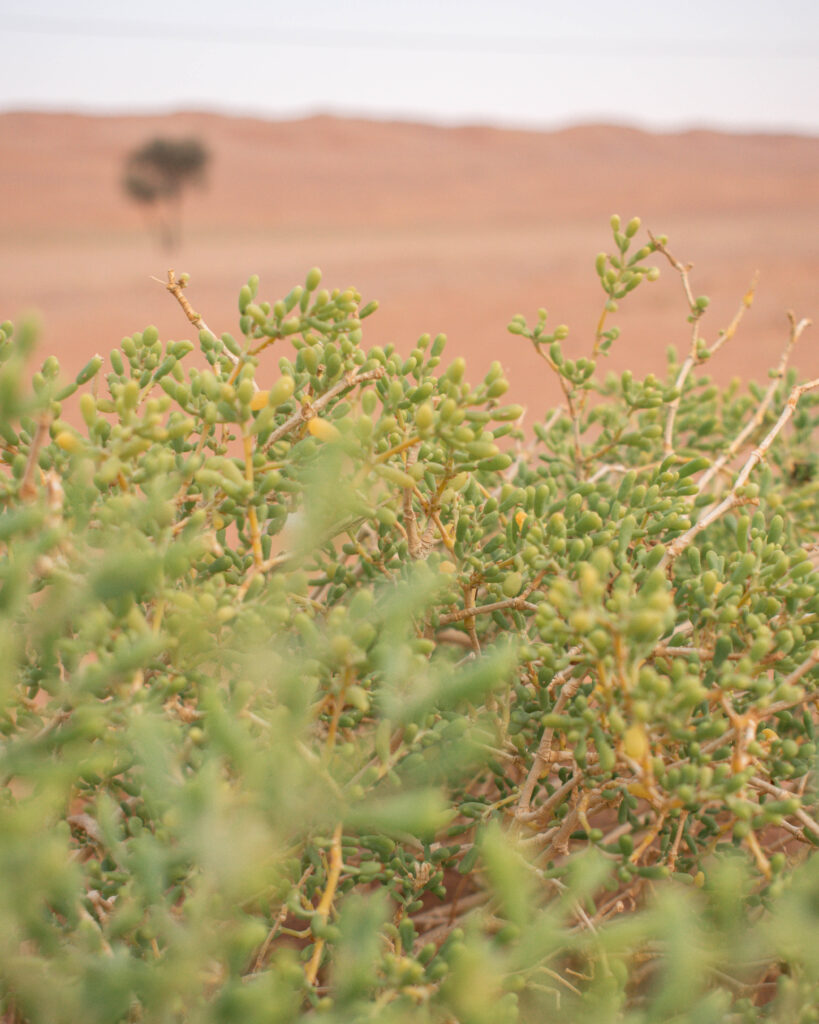
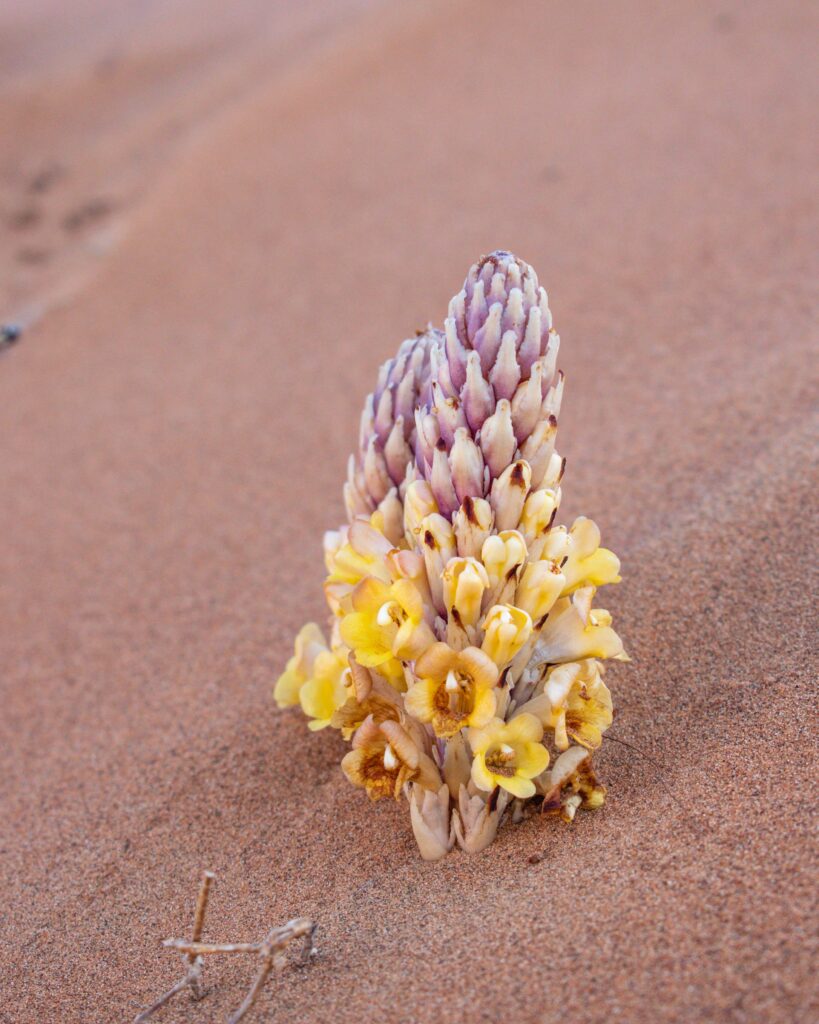
Now I have suitably terrified you… in several years of camping in the desert in Oman we have never seen a snake or scorpion in the dunes. And nor have most of our friends, although we often see tracks in the sand in the morning. You are infinitely more likely to hear a camel amble past in the night, than encounter a slithery companion in your tent.
Good advice is to wear shoes around camp, and make sure you give shoes and other clothes a good shake in the morning to ensure they have no new inhabitants. The same advice applies when packing away your tent and/or rug. When turning over rocks always do so with your shoed foot, and not a bare hand, to check no one is sheltering in the shade sun underneath! Always fully close your tent at night.
DESERT CAMPING HYGIENE
The winds often pick up in the afternoon in the desert, especially in Wahiba. Everything will get dusty. No matter what you do – and I have tried it all – there will be sand everywhere within minutes of your arrival. You simply have to embrace it, and learn to appreciate the sheer joy of that first shower after a night or two camping in the desert!
When using the bathroom, pick a spot a decent distance away from your campsite (decent clearly being relative to how close you and your desert camping companions are!) and dig a hole at least 15cm/6″ for any solid waste. Bury it when you are done.
Remove ALL toilet paper to dispose of properly with the rest of your rubbish, when you leave the desert. The lack of moisture means it will not decompose if you leave it.
Good etiquette anywhere in the world is to ensure you are 60m/200 feet away from any trail or path, and certainly from any water source, before going to the bathroom.
DRIVING IN THE DESERT
Off roading in the desert is seriously good fun. But it is also a skill, and not to be underestimated. Do your research before you leave, and have a safe trip which is memorable for all the right reasons.
4WD – although some of the tracks close to the start of the dunes of Wahiba are more compact, a 4WD is essential for driving in the desert. As is the ability to select a locked differential in a lower gear range just in case you get stuck. Knowing when and how to use the different modes is essential and there are loads of good YouTube tutorials to explain the differences.
Fill you car – always fill your tank before entering the desert, and if heading into the most remote parts of the dunes (especially the Rub al Khali) consider taking additional jerry cans.
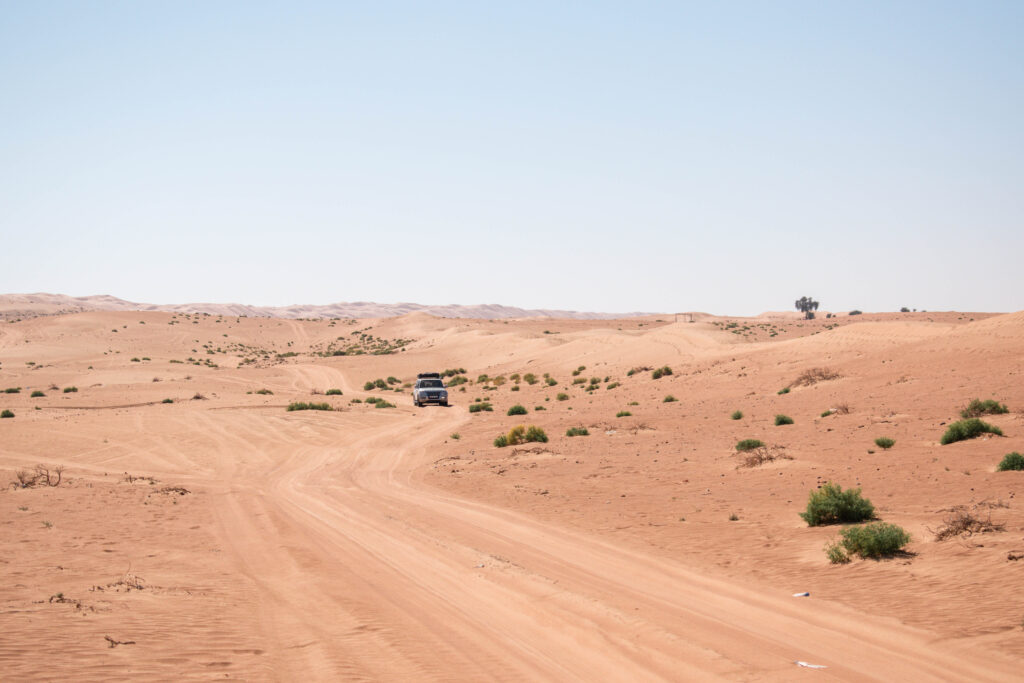
Switch off traction control – this helps prevent your wheels from spinning, which can dig you further into the sand if you get stuck. Remember some cars will automatically switch traction control back on, any time the engine is turned off and back on. In most cars, the switch is below the steering wheel.
Deflate your tyres – before driving on sand you should reduce your tyre pressure to around half-two thirds of their road pressure. This provides greater surface area, and spreads the weight of your car, giving you greater traction. It is also important to check your spare tire is in good condition.
Airbags – if you have side airbags, turn them off. The angles of the dunes can trick your vehicle into thinking it has rolled over. The last thing you want is a sharp blow to the face as you heroically summit a dune!
Go in convoy – if you are planning to head into the dunes or over soft sand, always take more than one vehicle and at least one experienced dune driver in your party. Ensure you also have sand ladders and a shovel.
First aid kit – in the event of an accident help may be many hours away. Best practice is to have a tourniquet (and learn how to use it), electrolyte tablets and antiseptic lotion.
Fully charged mobile – even if coverage is patchy, you can usually get signal from a high point in the dunes. Make sure it stays fully charged with a solar battery pack. Let someone know where you will be going before you depart.
Satellite phone – if going seriously off the beaten track, consider renting or borrowing a satellite phone. Keep it charged up and hope you never need to use it, but if you do it could mean the difference between life and death.
WHAT TO DO IF YOU GET STUCK?
If you go desert camping, getting stuck is almost inevitable at some point. In our experience, Omanis are always ready to help slightly panicked looking desert visitors, and if they see you stuck will always stop to offer assistance.
Firstly, try not to get stuck in the first place by sticking to the tips above. Never stop or slow down whilst driving through deep sand – as soon as you lose momentum, you’re stuck.
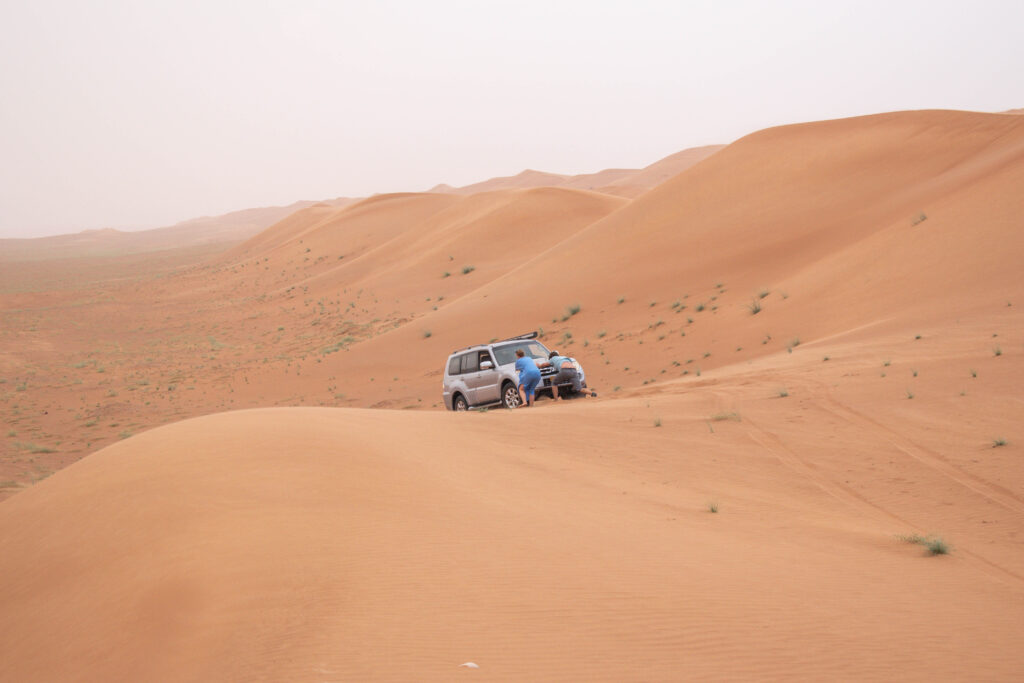
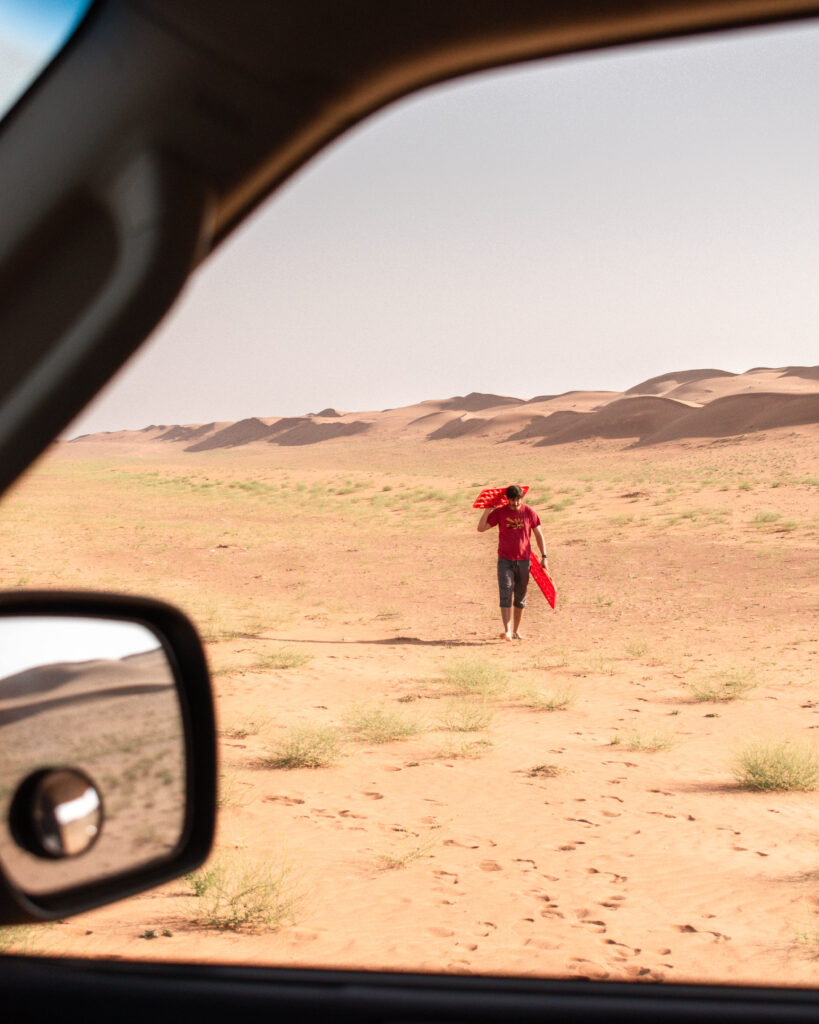
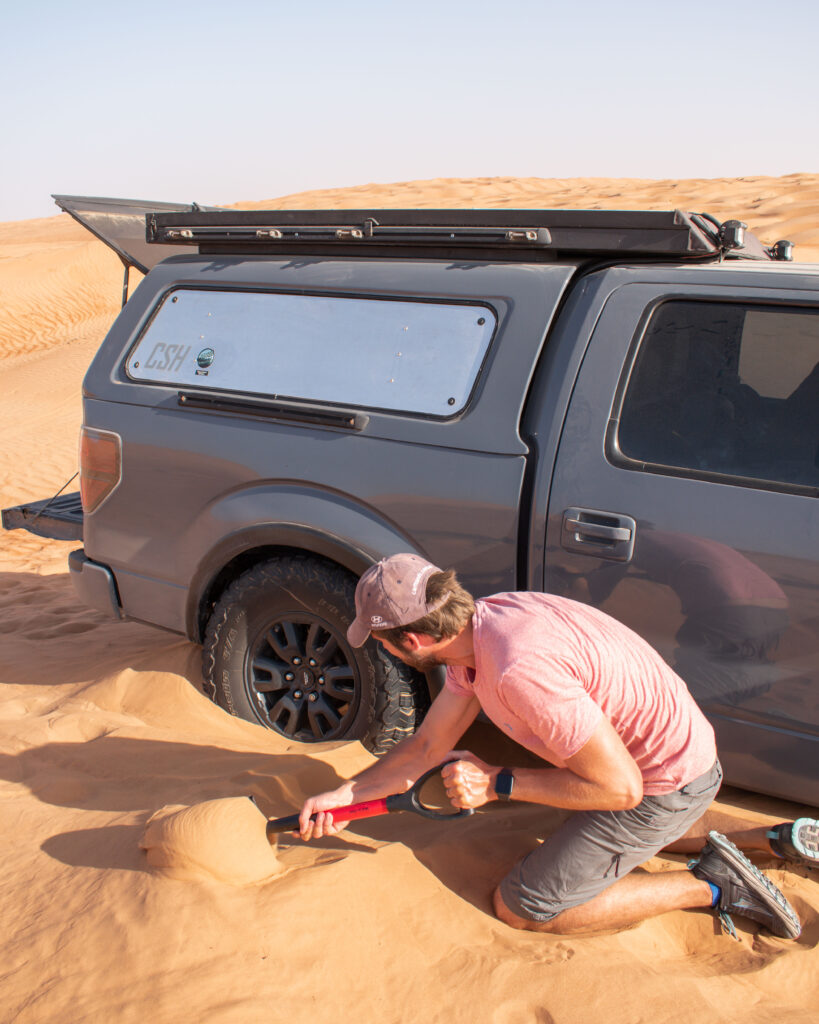
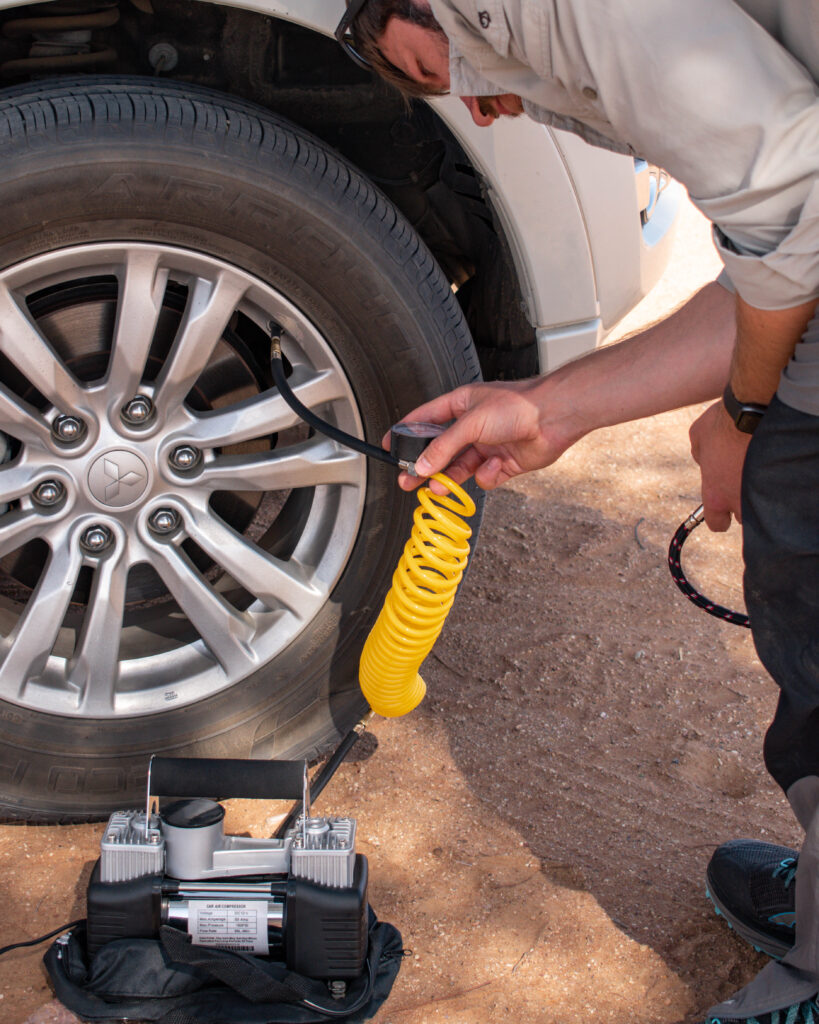
Once you are stuck, don’t let ego get in the way, and dig yourself in deeper by simply trying to rev your way out of the situation!
Dig out the sand from around the wheels, ideally with a shovel. Something flat and sturdy such as the lid of a food container will do in a pinch.
Sand tracks are fantastic if you are really stuck, but again you can improvise if needed. The rubber floor mats from your car can be wedged under the ties for more traction if needed.
WHAT TO PACK
Camping in Oman has brought about a transformation in The Husband. Previously he was on a never ending quest to find that bit of kit 0.00001g lighter than what we already had, or sneaking what he considered “extra” weight out of my rucksack when he thought I wasn’t looking. But here, everything is about comfort! Our roof tent is our most serious investment in comfort – I am going to find it hard to return to a ground tent when we leave Oman.
If you don’t bring your own, camping kit is available cheaply in all the big supermarkets in Muscat. Sultan Centre, Lulu’s and Carrefour have the best selection and there is a Decathlon in Mall of Oman. Don’t underestimate how cold it can get at night camping in the desert.
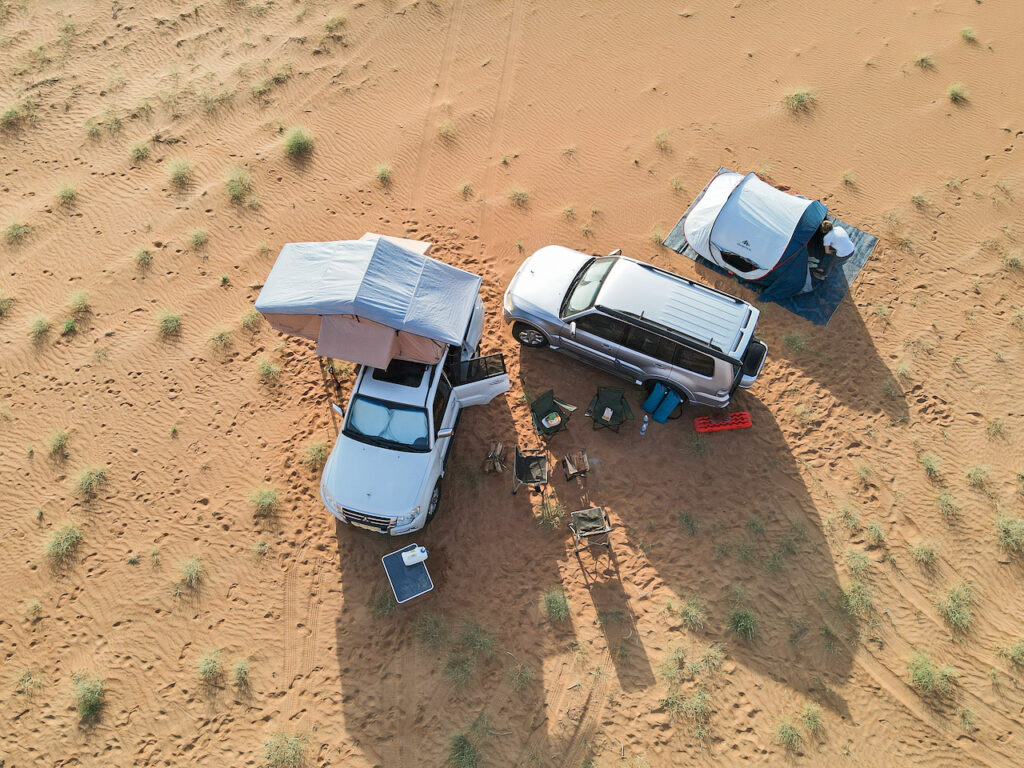
THE ESSENTIALS
- Tent – I say this is an essential, but actually sleeping out under the stars is magical. If you want to streamline your packing you can definitely do without – just be sure to pack warm clothes to sleep in during the winter.
- Camp beds – these cots have served us well on both wilderness adventures and multi-day music festivals!
- Sleeping bag – you will want something warm enough for the desert nights as once the sun goes down the temperature drops considerably.
- Sleeping mat – I love my thermarest. I have a terrible back and this is the best I have found.
- Headtorch
- Suncream, hat and sunglasses
- Toilet roll, small shovel for burying waste and a ziplop bag to remove used tissue paper.
- Warm jumper, warm socks and warm jacket – it gets properly cold on winter evenings.
- Cool box with ice packs for drinks and food. We find packing a small towel on top of the cool box really helps boost the insulation, and keeps everything much colder for longer.
- Sand ladders and/or a shovel – needed to dig your vehicle out if (when!) you get stuck.
- Two rubbish bags – one for recycling and one for waste. We are now obsessive litter collectors so tend to bring extra to try and clean up the spots we visit – take your rubbish home people!
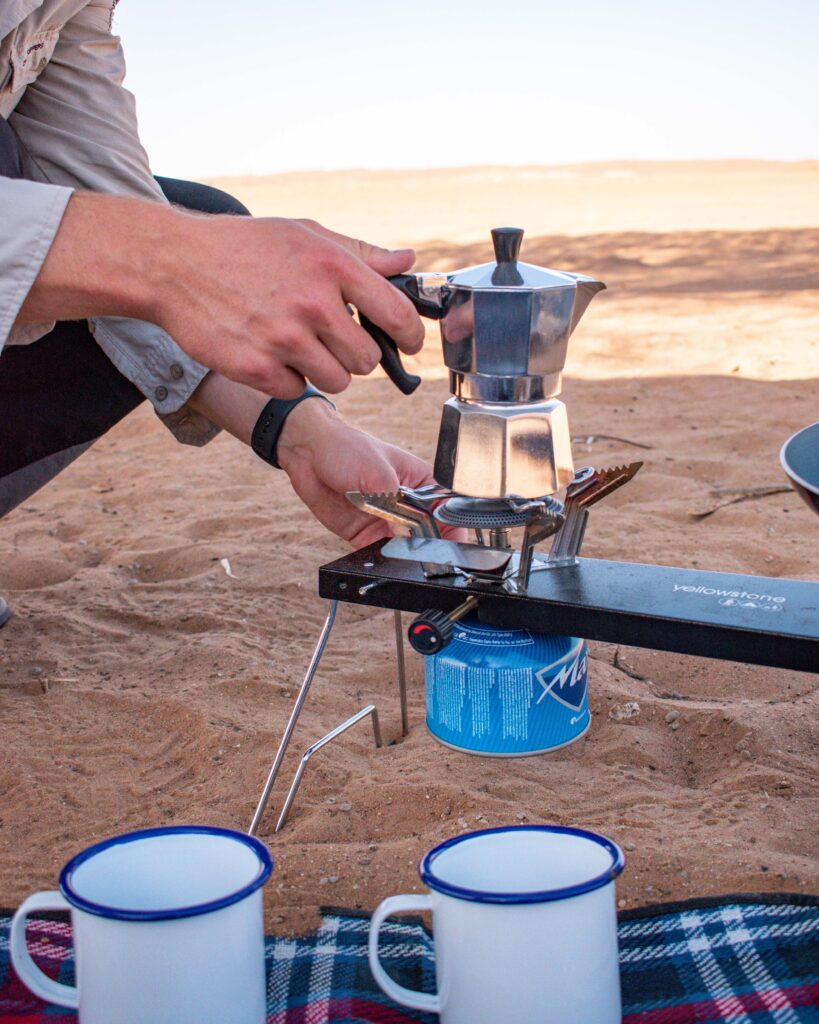
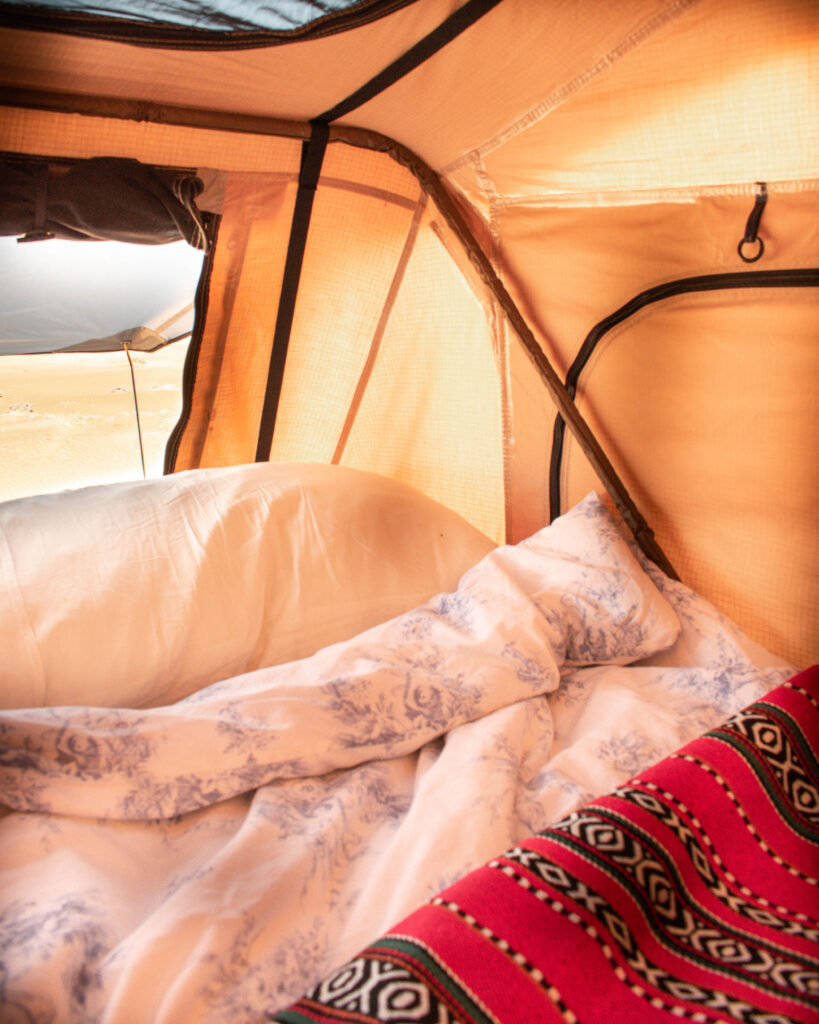
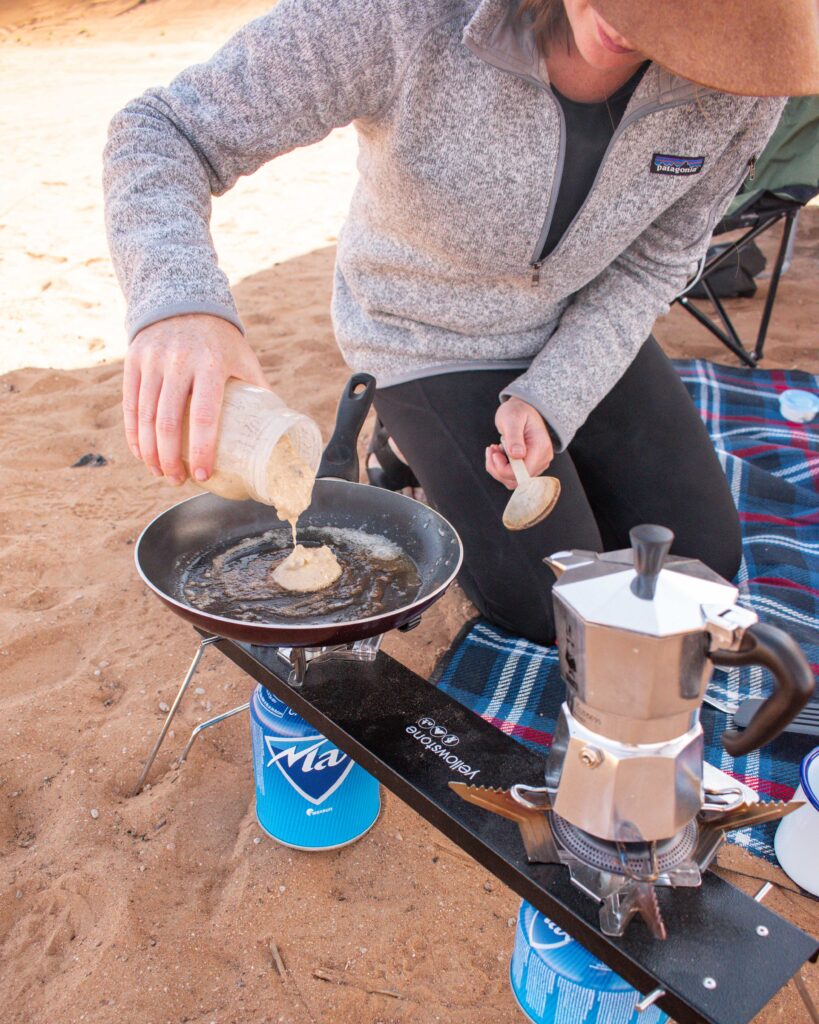
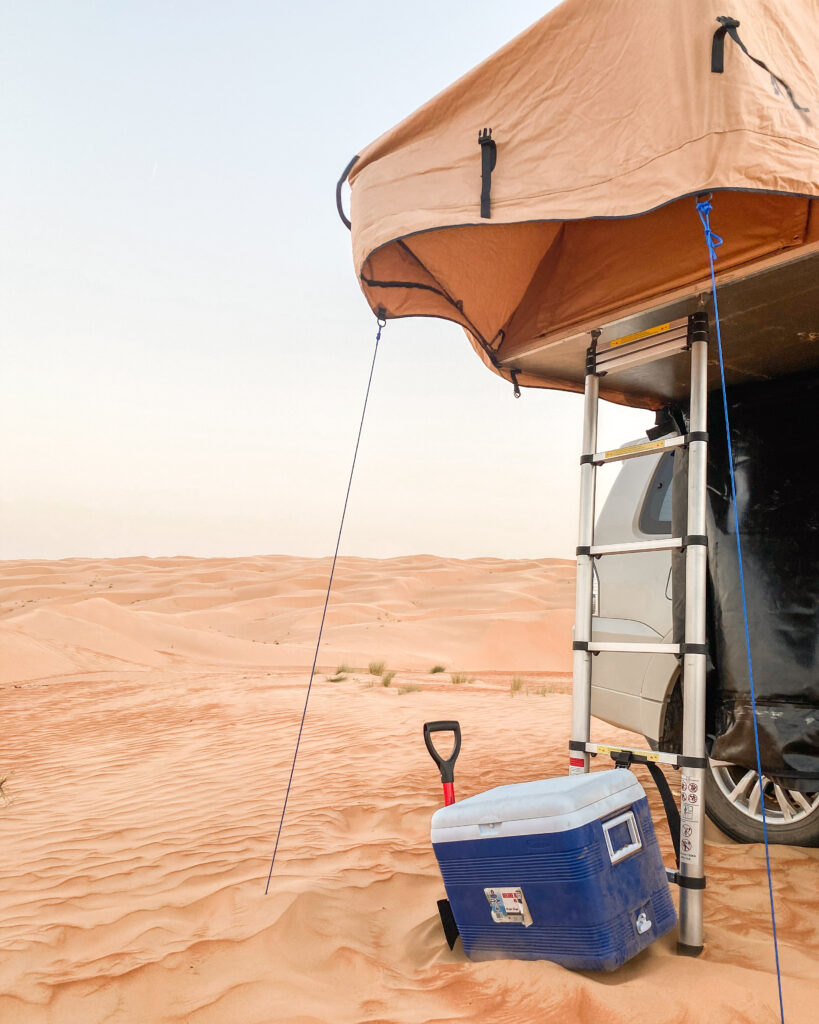
COOKING
- Camping stove (with gas!) or reusable BBQ (with fuel!).
- Pan and/or frying pan.
- Cooking utensils – we have a wooden spoon, spatula and tongs.
- Reusable cutlery – I love my vintage National Trust set as a bit of childhood nostalgia, but we also have a selection of sporks which are very hard wearing and do the job.
- Reusable plates/bowls
- Lighter and/or matches
- Sharp knife or multi tool.
- Moka pot, mugs and ground coffee – we can’t start a morning without a strong coffee! Alternatively, we have found this camping cafetiere to be an indispensable camp companion.
- Tuppaware box to function as a washing up bowl with small bottle of washing up liquid, sponge and tea towel. Or if you are like The Husband and have gone totally camping kit crazy, you can even buy yourself a collapsible washing up bowl…!
ADDITIONAL COMFORTS – THE NON ESSENTIAL ESSENTIALS!
- Camp rug – just be sure to check carefully underneath for new friends when packing away… scorpions and spiders may seek out the cool shade under tents and rugs in the hotter months.
- Camp chairs – can seem an unnecessary additional bulky item, but I think they are absolutely worth it for how transformative they are for your comfort!
- Folding camp table
- Shade – if you are heading desert camping in the hotter shoulder months, you may want to bring a tarpaulin or fixed car shade to offer a bit more respite from the heat.
- Solar camp light
- Small electric fan – the husband bought this for me to survive my commute on the London Tube. To be honest, I am still not completely convinced that camping in the Omani desert is the more inhospitable environment of the two…
- A proper pillow – I know you can get camping pillows, but real pillows genuinely transform a night’s sleep! And if you are camping with a car, why not?!
- Firewood (and marshmallows for s’mores, obviously) – since being in Oman we have got seriously into Swedish logs. They are found in most supermarkets here and are such an easy option. Otherwise all petrol stations and most supermarkets will sell logs. Try not to burn wood you find in the desert – often what looks dead is still very much alive!
GLAMPING IN THE OMANI DESERT
If sleeping in a tent is not your thing, you can still make the most of the Omani desert! Most of the fixed desert camps in Oman are found in Wahiba Sands. The majority offer a variety of tented structures – usually with solid walls – restaurants and even swimming pools. They also run excursions such as camel rides. Do your research to make sure you are comfortable with the camps approach to animal welfare before booking.
1000 Nights Camp – £££ – 41km into the dunes, this is about as far in as you can get and keep a hold of civilisation! Variety of room types on offer, but mostly based around comfortable, solid ‘tents’ with canvas roofs. Range of activities are available – such as camel rides and dune drives – but they are eye-wateringly expensive. Using the swimming pool in the middle of the desert however is free! Transfers available for 20 OMR per vehicle. Read my full review here.
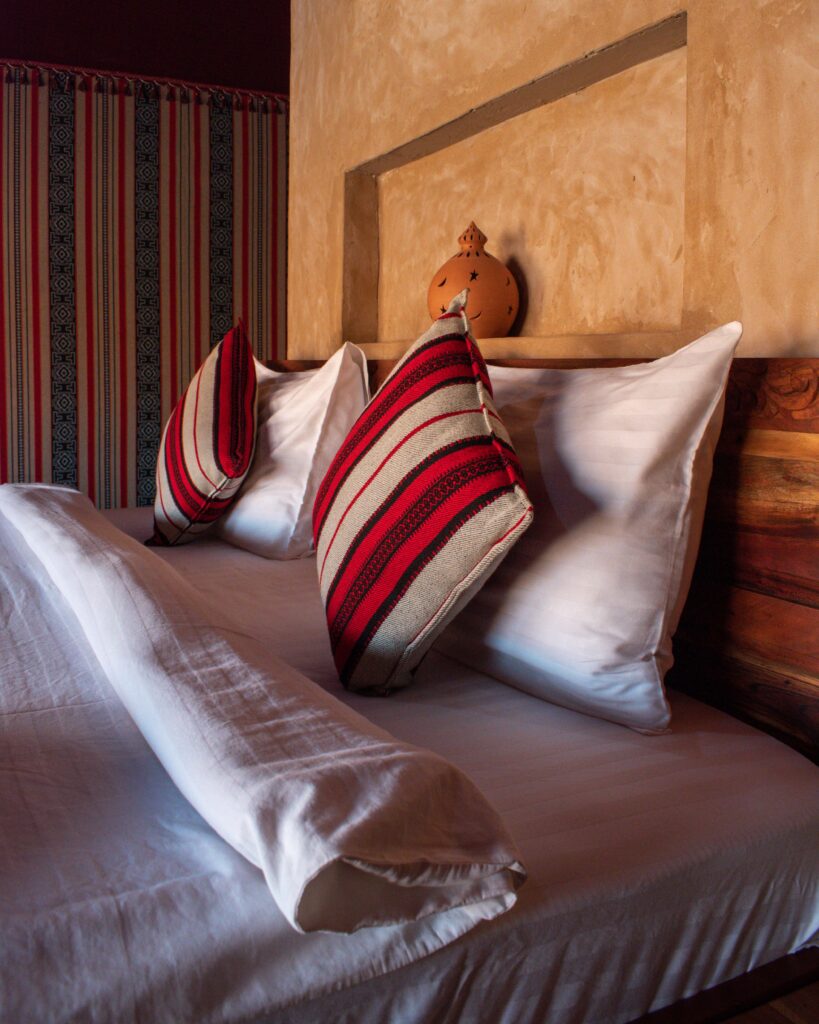
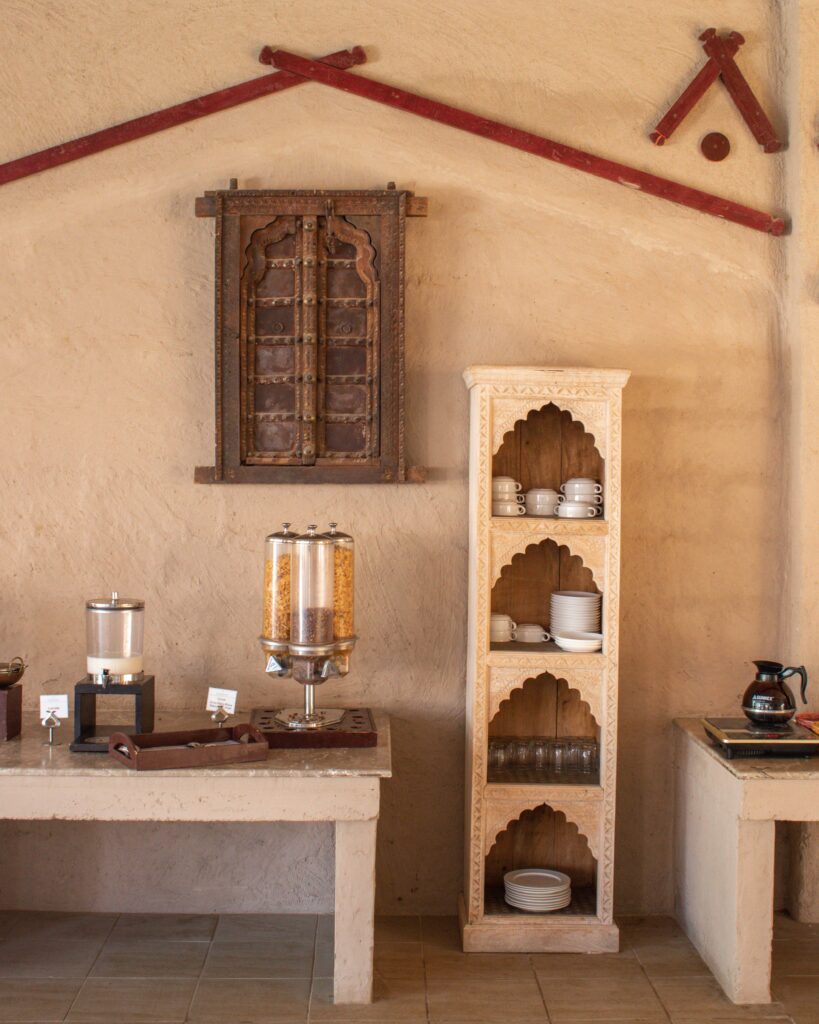
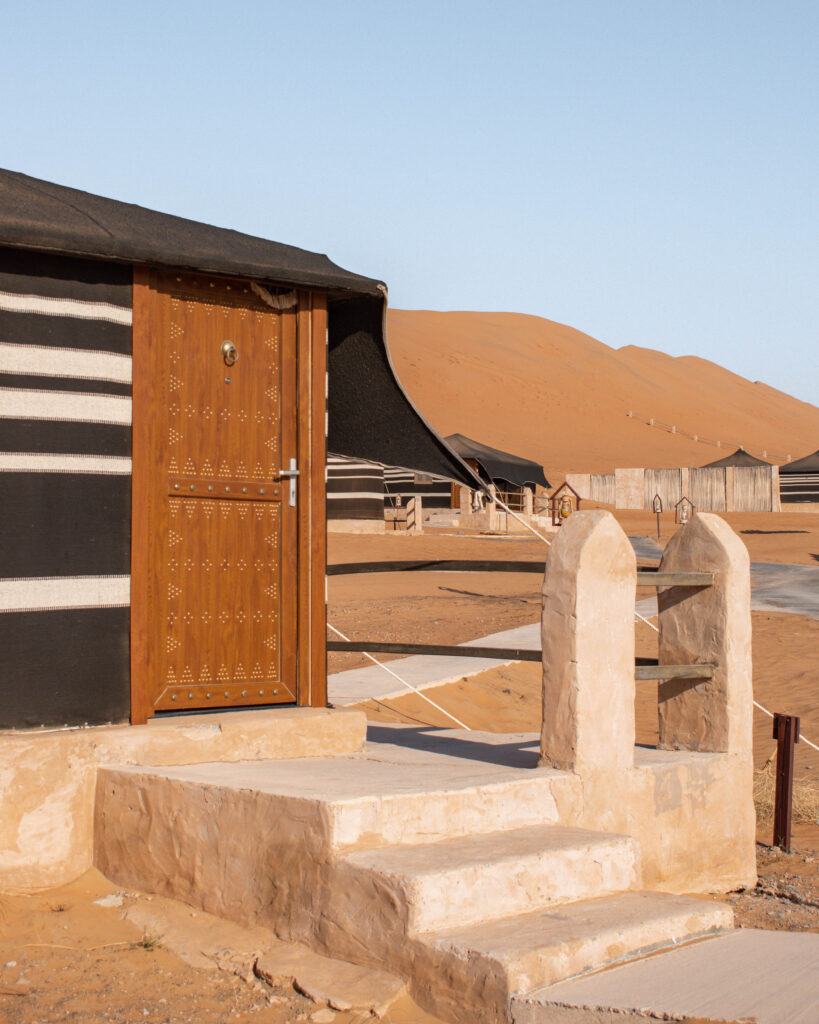
Desert Nights Camp – £££ – not as deep into the dunes as 1000 Nights, but similar vibe with fixed, solid tent-like structures. Slightly more luxurious than 1000 Nights, but the food is not as good. Range of activities on offer, all very expensive! Licensed. Some rooms have small pools.
Sama al Wasil Desert Camp – ££ – part of the popular Sama chain of hotels. Sat between two large dunes with a variety of activities on offer.
Oman Desert Private Camp – £ – a more basic option than the others on this list. The raised tent structures are spread out, and it has a more low key and private feel. If you are looking for an authentic desert camping experience, with a few mod cons, this is a good option. Transfers are included in the room rate.
Of all Oman’s landscapes, the desert is possibly my favourite (closely followed by the wadis!). It is a magical environment. So hopefully this has persuaded you to plan your own desert camping adventures. If you are planning a trip to the Sultanate, have a look at my guides to other Omani destinations. Otherwise, my adventure series offers inspiration for getting outdoors elsewhere in the world.




Leave a Reply